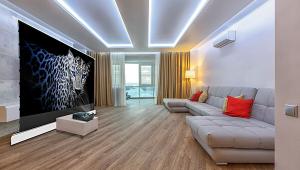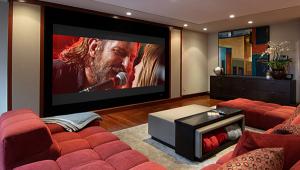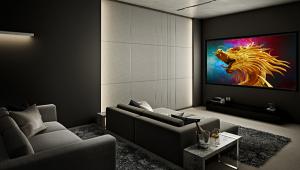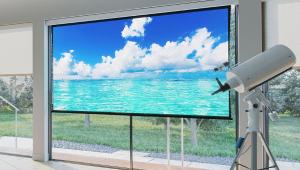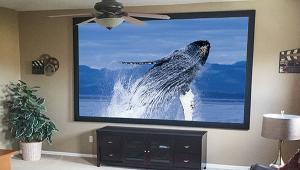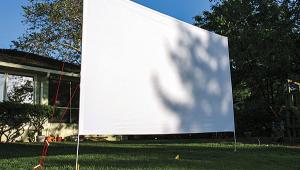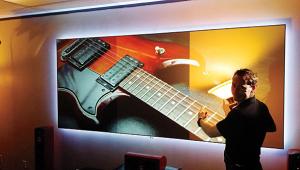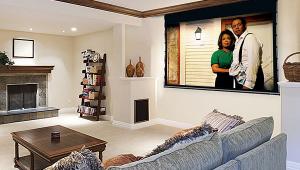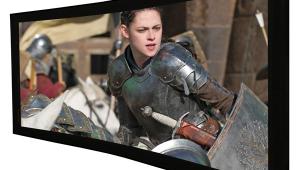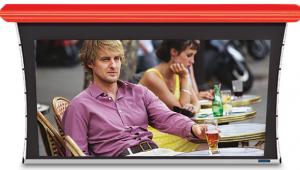Seymour-Screen Excellence Reference Series Enlightor 4K Acoustically Transparent Projection Screen

AT A GLANCE
Plus
Places center dialogue where it belongs
Good sound transparency
Minus
Light easily passes through it
Needs a bright projector to look its best
THE VERDICT
Acoustically transparent screens aren’t for everyone. None of them is totally transparent to sound, and all of them—this Seymour no less so than others—allow some light from the projector to pass through. But if your system demands such a screen, the Seymour is well worth a close look.
At the 2013 CEDIA Expo, many of the home theater demos used acoustically transparent screens. And a number of them—including those from Wisdom Audio, Datasat, and Digital Projection—used screens from Seymour-Screen Excellence.
Seymour makes screens with two acoustically transparent fabrics. The Enlightor 4K—reviewed here—and the Enlightor-2. The former has a smoother, less textured surface and slightly less gain, and the 4K version has received ISF certification.
Pros and Cons
There are two types of acoustically transparent screens: woven and perforated. In the latter, thousands of tiny holes are punched in the screen. Woven screens are self-
explanatory in their design, and
if the weave is fine enough, it shouldn’t be visible from a normal viewing position. Perforated screens can produce moiré patterns if the pixels in the image interact with
the holes, a problem that can be avoided with careful setup. Woven screens can slightly obscure the pixel structure, making it a bit more difficult to adjust the focus from close to the screen.
An acoustically transparent screen can also compromise, however slightly, the performance of both a projector and the speakers positioned behind the screen. Just as there is no speaker grille that is absolutely transparent, no acoustically transparent screen is perfect, either. And any texture in a screen—be it holes or a weave—can, at least in theory, affect resolution (though Seymour promotes that its Enlightor weave does not).
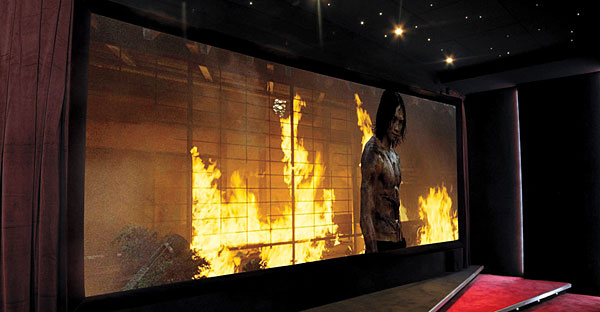
The more transparent a screen is to sound, the more transparent it is to light as well. Any light that passes through the screen is lost to the picture, with a loss of brightness. If enough light passes through, it can also reflect from objects behind the screen and bounce back through it. And if there is any shiny bling on the speakers themselves, it will be clearly visible on bright scenes.
To avoid the light reflection issues, many acoustically transparent screens position an additional layer of dark, grille-cloth-like material behind the screen. But that solution now means that there are two layers of “acoustically transparent” material between the speakers and the listeners.
An acoustically transparent screen does, however, have its advantages. All three front speakers can be placed behind it, which often allows for a much larger screen. It may also allow for identical speakers across the front, instead of a left/right pair and a different, horizontally arrayed center channel. In this situation, you can more optimally position the left and right speakers instead of having to spread them 12 feet apart on either side of a large, conventional screen. And with the center speaker behind the screen (whether or not the left and right are there as well), dialogue comes from where it belongs, from the actors’ mouths instead of their toes.
So although acoustically transparent screens aren’t for everyone, they do serve a definite need.
Setup
Seymour-Screen Excellence sent us a 2.37:1, 96-inch-wide, fixed frame, Enlightor 4K screen. Rather than the usual snap fasteners, the setup involved slipping the very thin, almost sheer screen fabric into a narrow slot with a special tool (provided) while stretching it enough to make it uniformly flat. The process was painless, except for a tiny wrinkle on one side that was totally invisible in use. We probably could have eliminated it by starting all over again but decided to leave well enough alone rather than risk damage to the material. Once the screen was assembled, we suspended it from the ceiling at the optimum height.
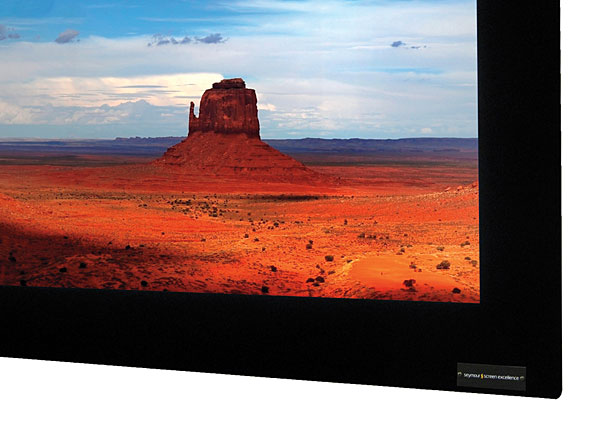
A Revel Performa3 M106 loudspeaker was positioned behind the screen with its tweeter about 45 inches above the floor (near center screen) and tilted slightly forward to compensate for my approximately 36-inch seated ear height. The front baffle of the speaker was roughly 6 inches from the back of the screen. The left and right speakers (Revel Performa3 F208s) were at the sides of the screen, not behind it. (The Revel Performa3 system was reviewed with the larger, heavier, dedicated C208 center speaker in our January issue—available at soundandvision.com—but the M106 was temporarily used as a center here.)
Seymour also provided a screen- sized piece of black grille cloth as the light-blocking backing mentioned earlier. This backing proved mandatory in my setup (its use is optional on the fixed-frame screens but comes permanently attached to retractable models). In my setup, the screen sits about 5 feet out from the back wall, and without the backing material, there was almost enough light spilling through on bright scenes to read by.
Listening and Looking
Because the screen was fixed and impossible to move out of the way without risking damage, I listened to the Revel M106 behind the screen and then compared it with the sound of another M106 in front of the screen. There are problems with this technique, the most obvious being that the two speakers are not in exactly the same place and we’re relying on close pair matching (not an unreasonable assumption in a $2,000 pair of Revels).
This issue aside, the process indicated that there was some loss of high-frequency air and detail when placing a woven screen plus a black scrim in front of the speaker. This was no surprise. Even behind the screen itself without the scrim, the speaker lacked a bit of its usual top-end sparkle. But in either case, the M106 was still well balanced and not at all dull-sounding or rolled off. And with the full 5.1 system fired up, the three front speakers—the M106 behind the screen and scrim and the F208s in the open at the left and right—the left-center-right match on films was excellent. The M106 used as a center couldn’t quite match the weight and power of a dedicated Revel C208 center mounted on its own stand in free space, but that’s hardly attributable to the screen.
On the picture front, I could tell immediately that the Seymour Enlightor 4K had a far lower gain than my resident, identically sized Stewart StudioTek 130 G3 (with 1.3 gain). At the wide open iris setting and Normal lamp mode, my JVC DLA-X30 projector (with just over 400 hours on its lamp) produced 24.6 foot-lamberts on the Stewart (far more than I’d ever use—I generally turn the iris down to well below its midpoint) and 13.08 ft-L on the Seymour. In other words, assuming the Stewart’s specified 1.3 gain is accurate, the Seymour’s gain in my setup was about 54 percent that of a StudioTek 130, or 0.7 (less than its specified gain of 0.95).
But the Seymour’s 13.08 ft-L still produced a pleasingly bright picture with my JVC. You won’t want to use it with a dim projector, but fortunately there are many even modestly priced designs, like this JVC, with adequate grunt—as long as you don’t want a monster screen size, or bright 3D. At CEDIA Expo 2013, Wisdom Audio was using a 21-foot-wide (!) Seymour screen for its 2D demo, but it was also using a $30,000 Runco three-chip DLP projector to drive a bright image.
As to image quality itself, I saw nothing in the performance of the Seymour that I found objectionable. Its uniformity was excellent, its colors bright and true, and its resolution (despite the screen texture—which was invisible from my 11-foot viewing distance) satisfying.
Conclusions
Since I also review speakers and projectors, I wouldn’t use an acoustically transparent projection screen in my own setup. But the Seymour-Screen Excellence’s Reference Series Enlightor 4K screen would definitely be on my list if I went that route for a permanent, dedicated theater installation. As with all such screens, it has its pros and cons, but it does offer a crisp, vivid picture with respectable transparency to sound.
- Log in or register to post comments

